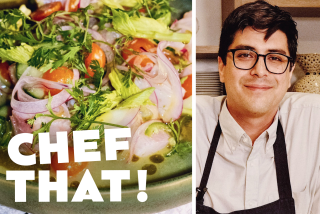A sure cure makes for delicious fish

There is an old road in Japan that runs from Wakasa Bay to the city of Kyoto known as the Saba Kaido, or Mackerel Road. For centuries, the road was used to carry fresh mackerel roughly 50 miles south from the sea to the former imperial capital during the time of the Tokugawa shoguns. Because there was no refrigeration, the prized fish were salted to preserve them for the journey. Itâs been said that if one transported the fish in a single trip, without sleeping, the brilliant blue fish arrived in Kyoto fresh and perfectly seasoned.
The art of curing is an ancient technique, born of necessity and found the world over. The process is simple: Combine salt, sugar and/or smoke to gently draw moisture from a food to preserve it over an extended period. Curing was especially instrumental in preserving more delicate foods, like fish.
Almost lost with the dawn of modern preservation methods such as refrigeration and canning, curing is making a comeback â and in a big way. Restaurants and chefs everywhere are touting cured meats, house-smoked specialties and homemade sausages. And, increasingly, cured fish.
âWeâre taking preserving techniques and starting to love the flavor,â says Marcus Samuelsson, founding chef of New Yorkâs Aquavit restaurant. He notes that the increasing popularity of regional cuisines, such as Swedish, are opening eyes to the possibilities with cured fish. Also, with the increasing popularity of sushi, people are starting to welcome different textures with their fish outside of cooking. âWeâre getting used to it.â
The process is simple. Curing fish takes very little active time and can be completed in a fraction of the time it might take to cure other meats. Since it requires no special equipment, itâs just as easily done at home as it is in a restaurant.
And the possibilities seem endless. A quick online search yields recipes calling for not only the more traditional gravlax and smoked salmon or trout, but also fish you might never have considered curing, including halibut, mahi mahi, striped bass and even tai snapper. The flavorings include classic dill, grappa and even kombu. Try curing fish with a tasso rub for Cajun-style flavor or take inspiration from a cocktail, combining rum and mint for a mojito-style cure.
Though almost any fish can be cured, make sure the fish is fresh and of the best quality. Be sure to buy from a reputable seller â the act of curing will not make a bad fish better or safer to eat. Salmon, in particular, should be bought previously frozen â salmon is anadromous, living in both salt and fresh water, and can pick up worms that other ocean fish donât; though curing can kill bacteria, only proper freezing can kill these parasites.
Keep the fish refrigerated at all times, even after it is cured. Home curing works to âdenatureâ the protein in the fish, in essence cooking it, but should not be counted on to render it safe left at room temperature.
If youâre new to curing fish, start with a basic, traditional recipe, such as gravlax.
Unlike the earliest versions of gravlax, in which the fish was buried in the sand by fishermen to cure (âgravâ meaning grave, and âlaxâ meaning salmon), modern methods are much simpler.
A fillet is coated with a basic blend of salt and sugar, with dill and liquor sometimes added for flavor. The fish is then wrapped and refrigerated until it is firm to the touch, generally two to three days. Follow the recipe exactly; if the measurements or timing are off, the fish might over-cure, rendering it too salty and tough, or it may under-cure, leaving the fish raw in places.
Wrap the fish, making sure to place it in a rimmed container before refrigerating to catch any juices that might drain out. Feel the fish for firmness to gauge the progress, and flip the fish if called for (some larger fillets are halved and sandwiched before curing; flipping redistributes the cure). The fish will be done when it is firm throughout; the timing will vary depending on the thickness of the fillet and type of fish.
After youâve cured your first fish, experiment a little. Keep the basic cure ratio (salt and sugar) the same, but substitute a different herb or liquor to vary the flavor.
Substitute chives for the dill in gravlax and brush the fillet with gin instead of aquavit. The chives are a nice complement to the salmon, the notes of onion and garlic apparent but not overly assertive.
As moisture is drawn from the fish, the flavor concentrates. Because of this, cured fish is best used as an accent, adding but one flavor to a larger harmony in a dish.
The chive-cured gravlax is excellent on a bagel with cream cheese but works equally well diced into a composed salad or perhaps shaved over a simple warm pasta. Toss bright red cubes of the gravlax with avocado and quick-pickled onion, dressed with a bright sherry vinaigrette as a take on ceviche. Or stir a little gravlax into a bean or lentil dish to give it extra depth.
For a more creative cure, try a ginger-lemongrass cure on a sable, or black cod, fillet. The fresh, clean flavors of ginger and lemongrass are a perfect complement to the rich buttery notes of the fish; tossed with crushed pink peppercorns, the final cure gives the fish a bright, delicate tang.
Try the sable sliced thin and served on its own as a sashimi course. Combine it with a seasoned panko mix and fry it like crab cakes, served with a lemon aioli. Or toss it with a salad of peppery greens for a contrast in flavors and texture.
As you become more comfortable with the curing process, continue to branch out.
Ken Oringer, chef-owner of the restaurants Clio and Uni in Boston, cures and dries sea urchin as one would tuna or mullet roe in Italian bottarga. He grew excited when he discussed the possibilities of cured fish, rattling off possibilities including a tuna belly prosciutto. âIt youâve got the time, itâs amazing cured!â
Masaharu Morimoto, chef-partner of Morimoto Napa and Morimoto NYC, cures yellowtail for a âyellowtail pastramiâ that he serves with togarashi spice as a coating. He says itâs one of the most popular dishes on the menu.
Samuelsson also cures yellowtail, which he uses in the mini tacos he serves at his restaurant, C-House, in Chicago.
Like many other cured foods, cured fish are sometimes smoked to complete the process or add flavor, as with smoked salmon and trout. Smoking lends a nice depth of flavor to fish â a richness â similar to that of meat.
For quick-smoked trout, submerge a half-dozen trout for several hours in the refrigerator in a brine flavored with a little garlic, shallot and bay leaf. Drain the trout and dry them on a rack overnight in the fridge to form a pellicle (a sticky surface to which the smoke will adhere). The next day, hot-smoke the trout over alder or applewood chips for about an hour until cooked through. If you donât have a smoker, the trout can be smoked using a converted charcoal or gas grill, or smoke indoors using a stove-top smoker or converted roasting pan.
The trout are rich, with a wonderful depth of flavor, and are perfect added to a breakfast hash or cold pasta salad. Flake the trout and use it in a dip, or make a quick rillette, combining the flaked trout with butter, capers, a little lemon juice and cracked black pepper.
Perhaps try adding the smoked fish to a sandwich. Chris Phelps and Zak Walters of Saltâs Cure in West Hollywood mention doing a club sandwich with house-smoked black cod as a slight twist on the classic turkey version.
Sometimes the fish isnât cured all of the way, but a similar seasoning mixture is added instead to infuse with flavor and only partially denature the fish â as with a marinade.
Michael Cimarusti, chef-owner of the restaurant Providence in Los Angeles, recently mentioned the Mackerel Road as he explained some of the common Japanese quick-curing methods he learned while working in Kyoto.
In the back of the restaurantâs kitchen, he removed a beautiful piece of halibut heâd quickly cured in salt. After an hour, the salt is rinsed from the fish, which is then refrigerated until it forms a pellicle. The halibut is then quickly seared in a hot pan and set aside to rest and cool before serving. The quick curing allows the fish to be cooked to a lower temperature, making for an extra-moist piece that flakes into large, luscious chunks.
Fresh, and perfectly seasoned.
More to Read
Eat your way across L.A.
Get our weekly Tasting Notes newsletter for reviews, news and more.
You may occasionally receive promotional content from the Los Angeles Times.











